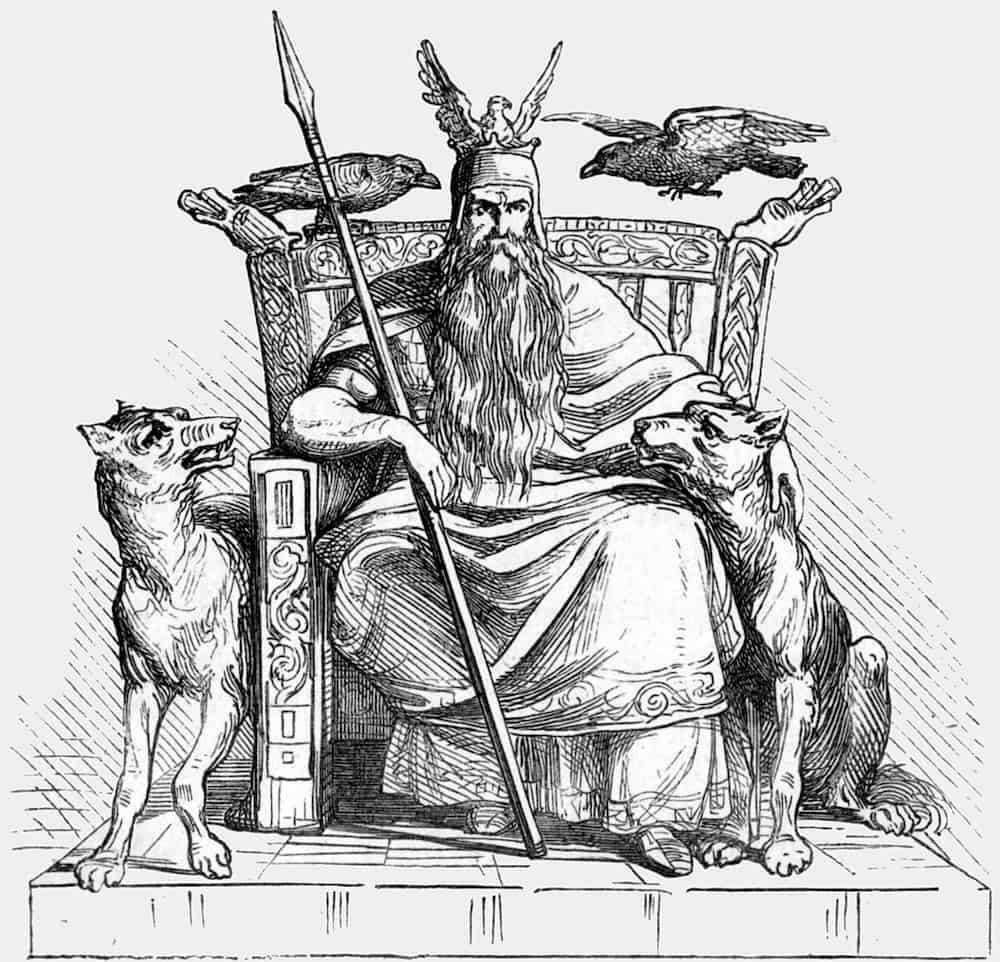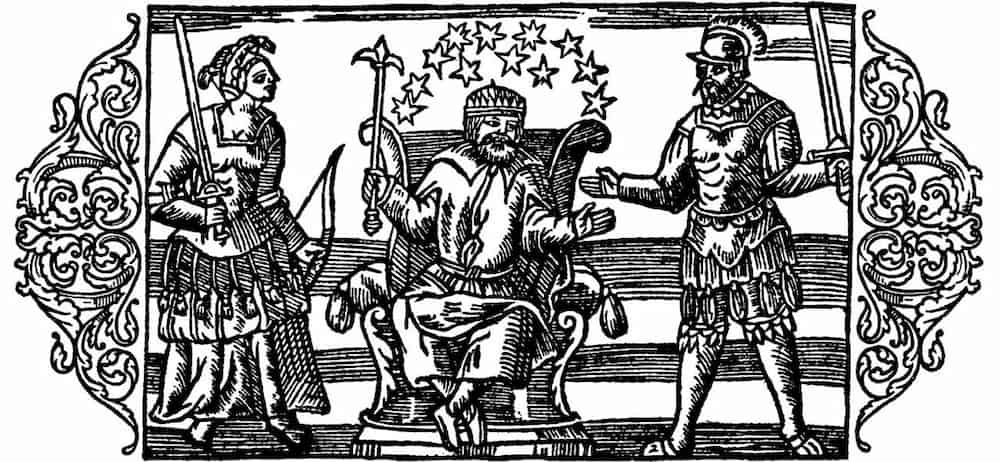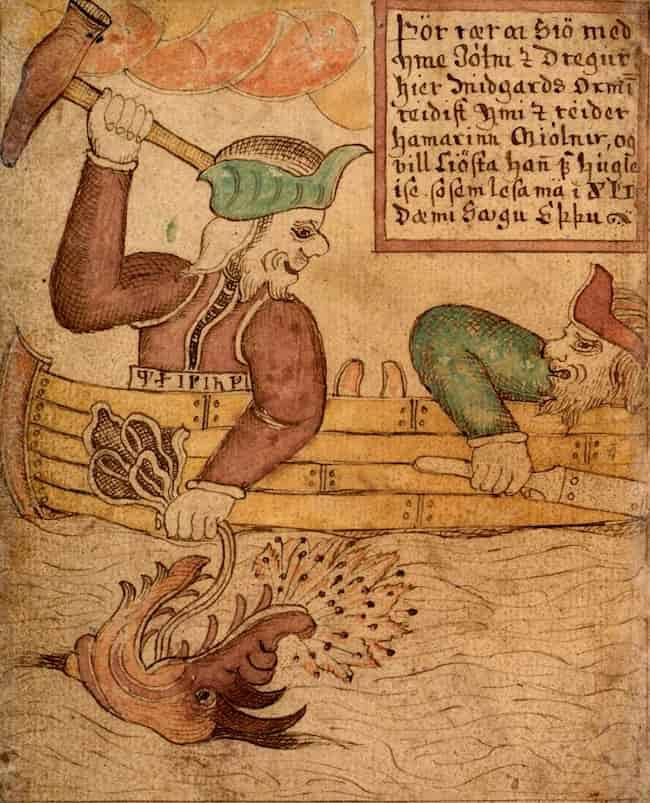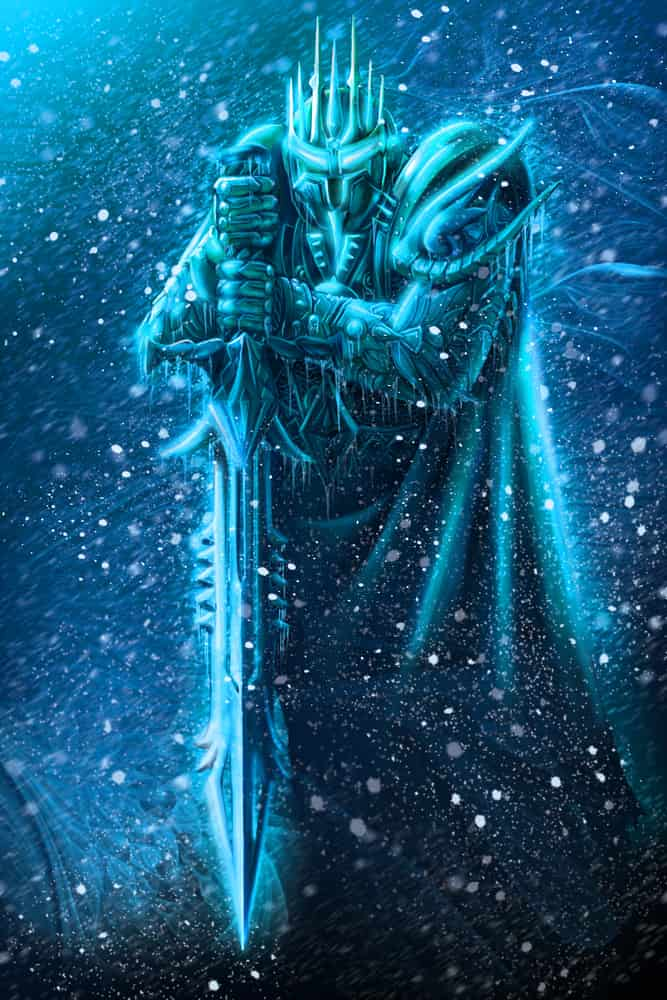A strong foe is needed to highlight the strength of a hero, and the giants of Norse mythology contained in Viking lore served as the counterparts to the Aesir, the Norse pantheon.
While the Jötunn or Jötnar certainly were a formidable enemy, they played a much larger and more complex role in Norse mythology than simple antagonists.

Table of Contents
What does “Jötunn” mean?
While “giant” is the easiest translation of jötunn and many of them were much larger than humans, the term also means something akin to “ogre”, “troll”, or “monster”, due to the fact that not all jötunn in Norse mythology were actually gigantic. Alternative diacritical spellings include jǫtunn, iötunn, and iǫtunn.
English speakers will frequently write the name of the giant species as jotun to avoid using the diacritical marks and to slightly cut down the number of characters without a loss of meaning. The word traveled to Britain in the form of eoten or ettin, Old English for “giant”.
Who are the giants in Norse mythology?
The giants of Norse mythology were called Jötunn, or the Jötnar. Some were large, but all possessed some form of immense physical or mystical power that rivaled or surpassed the gods of the Norse pantheon. They represented both natural and mystical forces, compared to the Aesir representing characteristics of mankind.
The often magical and larger-than-life nature of the jotnar serves as a vessel for explaining the natural forces of the world. Comparatively, the Norse gods of the Aesir are similar to those of other pagan religions in that they embody several characteristics of mankind.
Though it was often the father’s attributes that determined how the divinities were sorted in hybrid situations, the Norse pantheon was directly related to the giants. Odin and Loki, two of the most famous Norse gods, were both half-jotun. Loki’s father was the jotun Farbauti, and Odin’s mother was the jotun Bestla. Skadi is counted amongst the Aesir, and she was fully a jotun.

It is possible that the merging of natural and manmade forces in the Aesir symbolized how humans are both a part of nature and distinctly unique creatures within our small corner of the universe.
What are fire giants called in Norse mythology?
The fire giants were also called jotun, just as the frost giants are called, but they were typically identified explicitly as fire giants when frost giants might not. This relates to the fact that the word used for giants in Old Norse conveyed a sense of natural destructive forces as much as it meant they were large in size.
Both frost and fire giants were worries to the people of Midgard, but the frost giants play a larger role in most stories of Norse mythology, likely due to the climate of the region.
Related: What Language Did the Vikings Speak?
Are there frost giants in Norse mythology?
The frost giants are one of the two divisions of giants in Norse mythology. Of the major categories of jotun, the frost giants are by far more numerous and involved in the stories. If a jotun is mentioned without a clarification of its type in a Viking myth, then it is most likely a frost giant.
Many go unnamed, serving as fodder for the exploits of jotnar-slaying experts like Thor, but there are still a vast number of uniquely identified frost giants.

Who were the frost giants in Norse mythology?
All frost giants are descended from Ymir, the first giant that formed from primordial forces. Throughout the mythos, they both challenge and aid the Aesir. The full list of the jotnar and their offspring is extensive due to their presence throughout the Eddas, Heimskringla, Gesta Danorum, skald poetry, and other sources.
Even if you’re not aware of it, anyone who knows even the slightest bit about Norse mythology will have heard the name of a frost giant or one who shares their blood.
What did the Jotnar symbolize in Norse mythology?
The Jotnar were powerful beings that symbolized fundamental natural forces. Those who joined the Aesir likely showed how humanity and nature were intertwined. Due to the destruction of Ragnarok and the troubles the Aesir have with the jotnar throughout Norse mythology, it’s easy to see the jotnar as purely antagonistic.
Some were, but a jotun symbolized much more than a simple representation of evil.
From the beginning, mankind could not have existed without both the Jotnar and the Aesir. The conflict between the two gave Odin and his brothers the raw materials needed to create Midgard, the world of mortals that represents Earth.

The Asa themselves were largely related to the jotnar. Odin and his brothers were the sons of Bestla, a jotun. Loki’s father was a jotun. Odin’s children, including Thor, were largely from consorts with jotnar.
Rather than being evil, the jotnar simply are. Many have foul motives, just as the Asa and mortals do, but their primary role in the stories was either to give the symbolic tenets of the gods a chance to shine or display the inevitability of nature’s triumph over whatever humans create.
You may also be interested in: Norse Runes: Ultimate Guide to the Vikings’ Nordic Alphabet
Where do the Jotnar live?
Individual jotun could be found throughout the realms, but most of the jotnar lived in Jotunheimr (Jotunheim). Fire giants lived in Muspelheim, a realm of fire spitting flames at the roots of Yggrassil. These places were two of the nine realms of the cosmos in Norse mythology.
That is, the cosmos of the Norse myths was divided into nine realms. Two of the nine were the domains of jotun: Jotunheim and Muspulheim.
Jotunheim has far more information about it in the myths, partially due to the fact that Thor could not travel over the Bifrost and had to go through the land of the jotnar to reach Midgard. As might be expected for the home of frost giants, the land was perpetually locked in winter. Given the tall mountains and thick forests that covered it, the realm would be easy to imagine for Scandinavians.
Muspulheim, on the other hand, either holds more secrets in the lost stories or is a simple place of eternal fire that needs no long-winded explanations. The embers from Muspulheim were said to flicker by the southern end of Yggdrasil.
Who was the strongest giant in Norse mythology?
No giant had quite the size and power of Ymir, the first jötunn. He was the ruler of the giants at their peak, and his downfall spurred both the rise of the Aesir and the creation of the world. Odin was undoubtedly the strongest of the Aesir, but couldn’t take down Ymir alone.
This is why his brothers, Vili and Ve, had to help him take down the largest and oldest of the jotun. The details of the battle are not as clear in the surviving texts as the details of Ragnarok, other than those involved and the outcome.

If those who weren’t pure jotun are excluded, such as the monstrous children of Loki, Ymir stands uncontested as the strongest giant. Allowing them adds Fenrir, the three-quarters jotun wolf child of Loki, as a strong competitor. Although Odin fights Fenrir much later, the apples guarded by Idunn keep the gods fresh and young until the final battle, so old age can’t explain why the wolf is strong enough to take down Odin.
You may also be interested in: Loki’s Symbol and Other Facts on This Famous Norse God
Other powerful giants in Norse mythology
1. Skrymir
Skrymir was strong enough to withstand three blows from Thor’s hammer directly to his face while sleeping, and his glove was so large that Thor and Loki thought it was a great hall.
Though Mjolnir was capable of felling a room full of other jotnar in short order, Skrymir was able to pretend that they were little more than a small annoyance. In truth, the blows were strong enough to nearly kill Skrymir and leave indentations the size of valleys. Even if he didn’t get into a direct conflict with Thor, his ability to endure the strikes is indicative of the power he likely possessed.

In addition to withstanding the blows, Skrymir’s magic is strong enough to cast illusions over Thor, Loki, and their traveling companion after getting his head pummeled. Disguised as Utgard-Loki, he makes the three attempt challenges that appear easy, but the true conditions are much more difficult. Thor’s challenge is to lift a cat and wrestle a woman, who in actuality are Jormungandr the World Serpent and Old Age. When the ruse is discovered, Skrymir vanishes before Thor can swat him with the hammer.
Skrymir is not directly mentioned in the events of Ragnarok, so a true test of his power is never shown. Also of note, the Gesta Danorum‘s version of Utgard-Loki is that of a giant who is sizable and smelly, though he is bound.
2. Fenrir, the Wolf
Fenrir is one of Loki’s three monstrous children and a formidable foe in the battle of Ragnarok. The Aesir knew that Fenrir would be trouble due to the prophecy, so they attempted to bind him and prevent the death of Odin
The wolf manages to devour Odin even with the aid of all the einherjar, the souls of valiant warriors who were selected by the Valkyries after dying in battle. It’s hard to quantify how many einherjar would be equal to two gods, and there is no exact number given anyhow.
3. Jormungandr, the Midgard Serpent
Jormungandr is another of Loki’s monstrous children, though this one is a snake that grows so big it can reach around the world and bite its own tail.
Aside from Odin and Baldr, who was dead by the time of Ragnarok, Thor was the Asa most known for strength in battle. Jormungandr and Thor had a mild run-in when Thor was under the power of Utgard-Loki’s illusions. That tale shows how the serpent is too large for Thor to move more than a small amount. Later, Thor fishes up the serpent and nearly smites it with his hammer, but the giant Hymir cuts the serpent free.

When the two meet in Ragnarok, the battle is technically won by Thor. Despite his victory, Thor walks nine steps before falling victim to the venom coursing through his body, there from a wound given by the snake’s fangs. The vague nature of the battle makes placing the exact strength of Jormungandr difficult, but losing in a one-on-one fight ranks him below the other three.
How tall were giants in Norse mythology?
Giants varied widely in size, but the tallest would be the nearly almighty Ymir’s world-creating body. Ymir’s measurements were not given out in exact detail, but it is clear that he was enormous from the amount of things created after his death at the hands of Odin and his brothers.
Of old was the age | when Ymir lived;
Sea nor cool waves | nor sand there were;
Earth had not been, | nor heaven above,
But a yawning gap, | and grass nowhere
Voluspo 3
When Ymir came into existence, the mortal world of Midgard did not yet exist. From the drippings of a venomous river, Ymir sprung into existence within the “yawning gap”.
Of Ymir’s flesh | the earth was fashioned,
And of his sweat the sea;
Crags of his bones, | trees of his hair,
And of his skull the sky.
Then of his brows | the blithe gods made
Midgard for sons of men;
And of his brain | the bitter-mooded
Clouds were all created.
There were enough bits and pieces of Ymir for the brothers to create the mortal realm and its key inhabitants. While described in an illustrative manner and subject to how big the Vikings thought the world was, Ymir was a massive being whose body was large enough to host all the objects within Midgard.
Looking to other giants, the described size rapidly decreases. Skrymir, the next largest giant mentioned in the myths, is still a massive being that fills the surrounding terrain. He was clearly able to disguise his actual size through magic, as he did when pretending to be Utgard-Loki while hosting Thor and Loki.

The hill-giants that King Harald avoided in the Heimskringla were said to be taller than the nearby mountains and armed with a giant iron staff. Given Harald’s lack of a hammer like Mjolnir or the power of an Aesir, it’s understandable why he would venture to a different land upon seeing giants of this size.
From there, the question becomes more obscure. It’s possible that the Vikings expected everyone to know that the jotun were taller than humans and many of the Aesir in their natural forms, so mentioning it wouldn’t be worth the space on the page.
Are Norse giants actually giants?
The jotnar of Norse mythology were frequently large and humanoid, but they were known as much for their shapeshifting abilities, magic, and overall strength. They were more akin to formidable personifications of natural forces that were often, but not necessarily, similar to giants.
The heights of Norse giants are not clearly described for most of the giants within the historical sources, but those that were described trended towards immensity. Some were notably enormous, such as Ymir, Jormungandr, and Skrymir, but even Jormungandr doesn’t fit the common definition of “giant” in modern fantasy settings. Giants can often use magic and other abilities, so the jotnar having that ability doesn’t strictly separate the two.
The largest giant ever described was Ymir, the first frost giant. His exact size is not given, but Odin and his brothers use the body of Ymir to create all of Midgard, the mortal realm nestled in what was once an empty space between the roots and boughs of Yggdrasil. He was ostensibly humanoid in shape, by the breakdown of parts used by Odin to create Midgard, so he would be close to a “true” giant.

Skrymir was also sizable and humanoid in his real form, fitting the common definition of a giant who happens to have magical powers. His glove was large enough that Thor, Loki, and their traveling companion mistook it for a strange hall. The blows that Thor smacked into his forehead were said to create three large valleys in the landscape.
Jotun like Ymir and Skrymir are close to modern fantasy giants, but looking at other jotun shows how that comparison fails to exactly line up.
Jormungandr is the child of Loki and the jotun Angrboda, making the Midgard Serpent three-quarters jotun. While massive enough to wrap around the world and bite its own tail, it’s more like a giant monster or kaiju from Japanese media influence than a fantasy giant. Fenrir, another of the monstrous mostly-jotun children of Loki, was a wolf that grew large enough to spread his jaws from the ground to the far reaches of the sky.

Hill-giants like the ones that King Harald saw were as tall as mountains. These would likely be a specific form of frost giant descended from Ymir. Their minimal mentions paint them as typical giants, though they may have had forgotten powers.
Who were the giants afraid of in Norse mythology?
The Aesir were the most powerful enemy of the Jotunn, ending the rule of the giants over the realms and frequently ending up in conflict with them. It would be too much to say that all of the jotnar were afraid of the Aesir, but no enemy caused as much trouble for the giants as the Asgardians.
The Aesir’s leader slew the progenitor of all the frost giants, Ymir. It could be said that some frost giants did warrant their deaths at the hands of the gods, like Thiazi, who kidnaped the goddess Idunn. Others, like Skrymir, were lounging in their own domain when the Asa decided to impose their will.
This ancient conflict comes to a culmination in the events of Ragnarok, the final battle between the Aesir and the foes they’ve made over the ages.
What are the giants in Ragnarok?
While the frost giants are the primary players in Norse mythology throughout many of the stories, both fire and frost giants come to battle in Ragnarok. Their fight with the gods results in the destruction of Midgard.
The details of the final battle can be found in the Poetic Edda‘s Voluspa and the Prose Edda‘s Gylfaginning. Both types of jotnar play a role in the conflict that brings about the end of all things.
What do the fire giants do in Ragnarok?
Surtr, the leader of the fire giants, directs his forces to cross the Bifrost, a rainbow bridge that connects Midgard to Asgard. The burning fire of red in the rainbow kept the frost giants from crossing it, but the blaze poses no threat to the giants of Muspelheim.
Instead, their weight proves too much for the delicate bridge that can’t hold Thor, and the rainbow breaks.
From there, the fire giants unleash the destruction of hellfire over Midgard. The power of their flames isn’t the sole cause of the end of Odin’s creation, but they go from embers at the south of Yggdrasil to a flame roaring over Odin’s creation.

What do the frost giants do in Ragnarok?
The frost giants kill many of the Norse gods and help destroy the realm of Midgard during the events of Ragnarok. Loki, the former Aesir, is himself half a jotun by his father, Farbauti. His three children by the jotun Angrboda are some of the most powerful and monstrous creatures in Norse mythology.
Those children are pivotal to the events of Ragnarok, perhaps pointing to the combined efforts of human guile and natural forces bringing about the end of the world.
Jormungandr, the Midgard Serpent, finally unleashes his grip on his own tail and starts to thrash, leading to giant floods of poisonous water across the world. The rise in sea level allows Naglfar, the ship made from the nails of the dead, to sail across the world, steered by the giant Hymir and the newly escaped Loki.
Fenrir, the wolf child of Loki, finally breaks free from the fetters of his ethereal, silken bonds. In the final battle, he overpowers Odin and swallows him whole, but he is soon stabbed through the heart by one of Odin’s sons, Vidarr.
Then to the Goddess | a second grief cometh,
When Odin fares | to fight with the Wolf,
And Beli’s slayer, | the bright god, with Surtr;
There must fall | Frigg’s beloved.
Odin’s son goeth | to strife with the Wolf,–
Vídarr, speeding | to meet the slaughter-beast;
The sword in his hand | to the heart he thrusteth
Of the fiend’s offspring; avenged is his Father.
Voluspo 53-54
Then, Thor faces off against Jormungandr. The giant snake falls before Mjolnir, but the venom that was strong enough to poison the ocean proves too powerful for Thor. He walks just nine steps before falling dead, though the Prose Edda suggests that Thor’s children will bring his hammer to the new world.
Hither there comes | the son of Hlothyn,
The bright snake gapes | to heaven above;
[…]
Against the serpent | goes Othin’s son.
In anger smites | the warder of earth,–
Forth from their homes | must all men flee;-
Nine paces fares | the son of Fjorgyn,
And, slain by the serpent, | fearless he sinks.
Voluspo 55-56
Loki engages in battle with Heimdall, the guardian of the Bifrost. Both end up killing each other in the conflict, showing that Loki was capable of fighting as much as tricking. Although Loki dies, the events set in motion are far beyond needing his active involvement by that point.
In the end, the battle results in the utter destruction of Midgard. There has been some scholarly debate about whether the later sections of the Voluspo are an addition from post-pagan poets, but there is no definitive evidence. Still, the devastation wrought by the jotnar is certain.
The sun turns black, | earth sinks in the sea,
The hot stars down | from heaven are whirled;
Fierce grows the steam | and the life-feeding flame,
Till fire leaps high | about heaven itself.
Voluspo 57
Norse mythology giants’ names
There are many giants mentioned within the ancient sources of Norse mythology, and a comprehensive list could go on for quite some time.
The list covers all of the jotnar mentioned earlier plus several other prominent names. Notably, partial jotnar that are typically categorized as part of another group, such as Odin and Loki, are not included.
- Ymir, the progenitor of the frost giants.
- Surtr, the ruler of the fire giants.
- Jormungandr, the Midgard Serpent and one of Loki’s children.
- Fenrir, the Wolf, who is one of Loki’s children and the slayer of Odin.
- Skrymir, the giant who withstood Thor’s blows and tricked him while disguised as Utgard-Loki.
- Farbauti, the father of Loki.
- Bestla, the mother of Odin and his brothers.
- Angrboda, Loki’s consort and the mother of his three monstrous children.
- Skadi, the jotun daughter of Thjazi, who is considered part of the Aesir.
- Thjazi, Skadi’s father and kidnapper of the Asa, Idunn.
- Suttungr, the giant from whom Odin stole the mead of poesy.
- Hymir, the giant who saves Jormungandr from Thor and steers the ship of dead men’s nails during Ragnarok.
